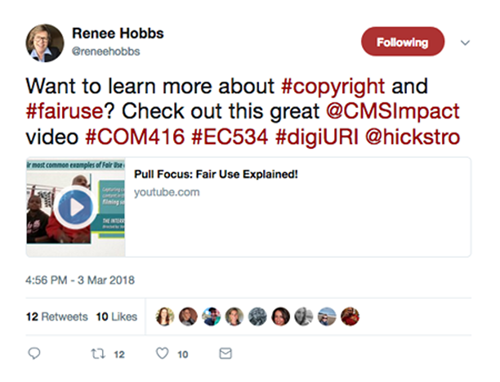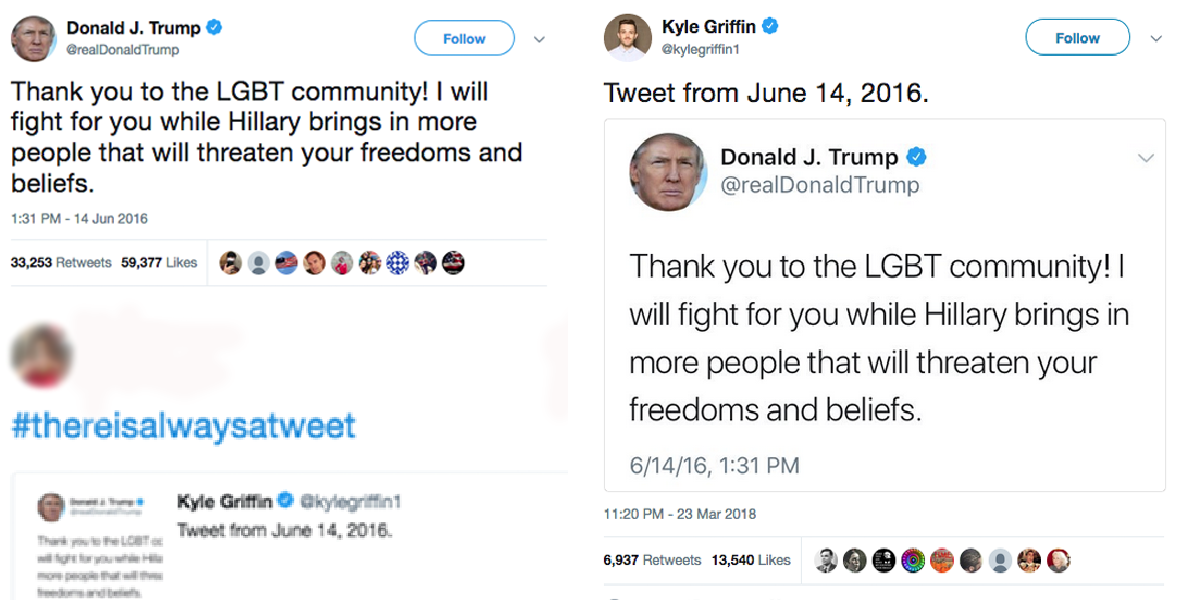Authorship and Copyright on Twitter
In 2017, Twitter published significant changes to their Terms of Service, sparking outrage among users about how the new terms affected users. The critique focused on a specific few lines within the terms under "Your Rights" that carefully discuss a shift in content use:
You agree that this license includes the right for Twitter to provide, promote, and improve the Services to make Content submitted to or through the Services available to other companies, organizations or individuals for the syndication, broadcast, distribution, promotion or publication of such Content on other media and services, subject to our terms and conditions for such Content use. Such additional uses by Twitter, or other companies, organizations or individuals, may be made with no compensation paid to you with respect to the Content that you submit, post, transmit or otherwise make available through the services. ("Your Rights;" Twitter Terms of Service)
Many Twitter users responded to this alteration of the Terms by tweeting the implications of these changes on what they believed constituted authorship. Conversations reached folks within the academic Twitter community who were concerned with the effects these changes would have on those who post their writing and art in the medium. Journalistic coverage of these changes, such as Sarah Buhr (2018) and Andrew Griffin (2017), presented these changes as par for the course of social media, arguing that the language pertained primarily to big media corporations needing to share newsworthy video, images, and updates. Since Twitter as a platform functions through widespread sharing of content (often in the form of retweets), such an argument does make sense. Nevertheless, concern remains over how such legal language impacts everyday users without a team of lawyers behind them to protect their content.
| Category | Category Attributes |
|---|---|
| Users | Students, instructors, parents, family members, administrators, prospective and current employers, publics, alumni, donors, journalists, government agencies, politicians, bots, trolls, political operatives, predatory actors, platform employees and staff, advertisers |
| Permissions | Platform access is provided for free;
instructors compel students to utilize social
media platform as condition of participation in
course. Click-wrap agreement where student agrees to platform terms of use Policies such as end-user license agreements (EULAs), as well as platform-specific copyright and privacy policies, govern use. Students might create public or private accounts making their contributions more or less visible to those outside of a course. |
| Inputs | Surface contributions:
140-280 character tweets, images, videos,
replies, links, retweets, quoted retweets,
likes, lists, profile information, hashtags,
URLs. Non-transparent and hidden contributions: Username, hashtags, source/device, tweet ID number, total number of retweets, if reply, screen names of those involved in conversation, number of times tweet has been replied to, profile background image, profile image, followers, statuses, description, friends, geolocation, date, time, geolocation, style, lexicon, IP address, interactivity/behavior within website, time spent logged in/active on website, file types and file metadata, browser used. |
| Operations | Students, instructors, and/or publics might
interact by tweeting, replying, liking,
quote-retweeting, retweeting, following,
unfollowing, listing. Each tweet/interaction is logged within a mineable database that is publicly available through the Twitter Firehose API to those who write proper script to pull down access to this information. Twitter may or may not collect/store other types of data/metadata, which are not publicly available. Twitter or 3rd-parties accessing tweets through the API may perform behavioral analysis and psychometric profiling based on semantic analysis of contributions, hashtags, interactions. Targeted advertising may be directed to students; algorithms may ensure specific types of content aligning with user tastes, values, beliefs, ideologies reach students. |
| Outputs | Twitter may create psychometric or behavioral
profiles on students from user interactions,
type of accounts followed, semantic analysis of
tweets, types of hashtags used, likes, and/or
retweets, which can be sold to third parties. Twitter, as a platform that supports interactivity, also collects and stores proprietary content, data, and metadata within a proprietary database. Proprietary algorithms may be trained by making use of this database. Twitter and third parties making use of the API may rapidly identify trends in news, markets, politics, social interests, memes. Twitter and third parties might trace and identify social networks that exist within and between users. These may be utilized to reveal social, professional, and/or familial relationships that exist outside of the platform. Twitter can sell or monetize content, data, metadata, profiles, or insights built on user contributions to third parties. |
| Gateways | Students and users gain ability to author and
interact with content in platform. Outside
individuals (those without accounts) can search
hashtags, visit public accounts, and read
content circulated within platform on front-end. Users can author API commands to access and pull down content, data, and metadata from Twitter firehose stream. Advertisers can pay for access and ability to target users through psychometric profiling. |
In an attempt to make clear to their users where they stand in regard to copyright, Twitter has offered users a standalone copyright policy, a policy that works in addition to the platform's general terms of service. This move is notable because many platforms stick strictly to terms of service or conditions and privacy policies.
Reading over Twitter's copyright policy illustrates that the platform carefully follows provisions regulating content management and circulation on platforms laid out in the Digital Millenium Copyright Act (DMCA), particularly Section 512. Twitter also has a separate sub-policy for trademark, which describes how the platform supports the protection of corporate entity or brand identities. They also have a policy for fan, parody, and commentary accounts—all of which they do not generally consider copyright issues. One critical point worth stressing is that across many of Twitter's policies there is never a clear indication whether the platform considers tweets themselves as copyrightable texts. Only the content that users upload, embed, or link to within the tweets can be protected—that is, if it contains already copyrighted or arguably copyrightable content.
The language in these policies offers relevant takeaways for those of us invested in the impact of copyright upon student authorship within the Twitter platform. For one, the language creates a literacy barrier for most users, which prevents users from fully understanding the legal processes that engender their participation in the platform. Secondly, and due to the first takeaway, a look at the language shows to whom these policies are actually written. Twitter's copyright policy, for example, is directed primarily at corporations who not only have the legal wherewithal to execute a copyright claim over their content, but also have the social and financial power to indebt Twitter's alliances to them. Everyday users with no corporate affiliation retain little to no protection via this policy. Such a policy model, then, enforces copyright within a hierarchical framework, protecting powerful institutions first and foremost—just as Dustin Edwards' (2018) analysis of YouTube's takedown processes illuminated. The unequal distribution of copyright protections over content shared through Twitter hints toward an understanding that Twitter may use their copyright policy as a mechanism for protecting the corporations who fund the platform's financial infrastructure through targeted marketing, paid advertisements, and promoted tweets.

